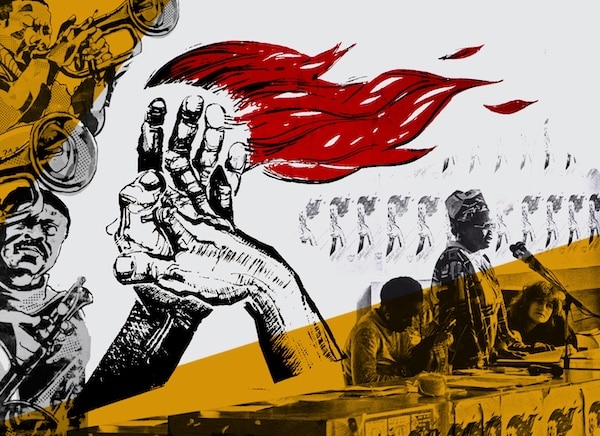The images in this dossier are from Freedom Park’s Medu Art Ensemble Collection, which contains 150 digitised materials that are currently hosted on the University of California, Los Angeles Library website.
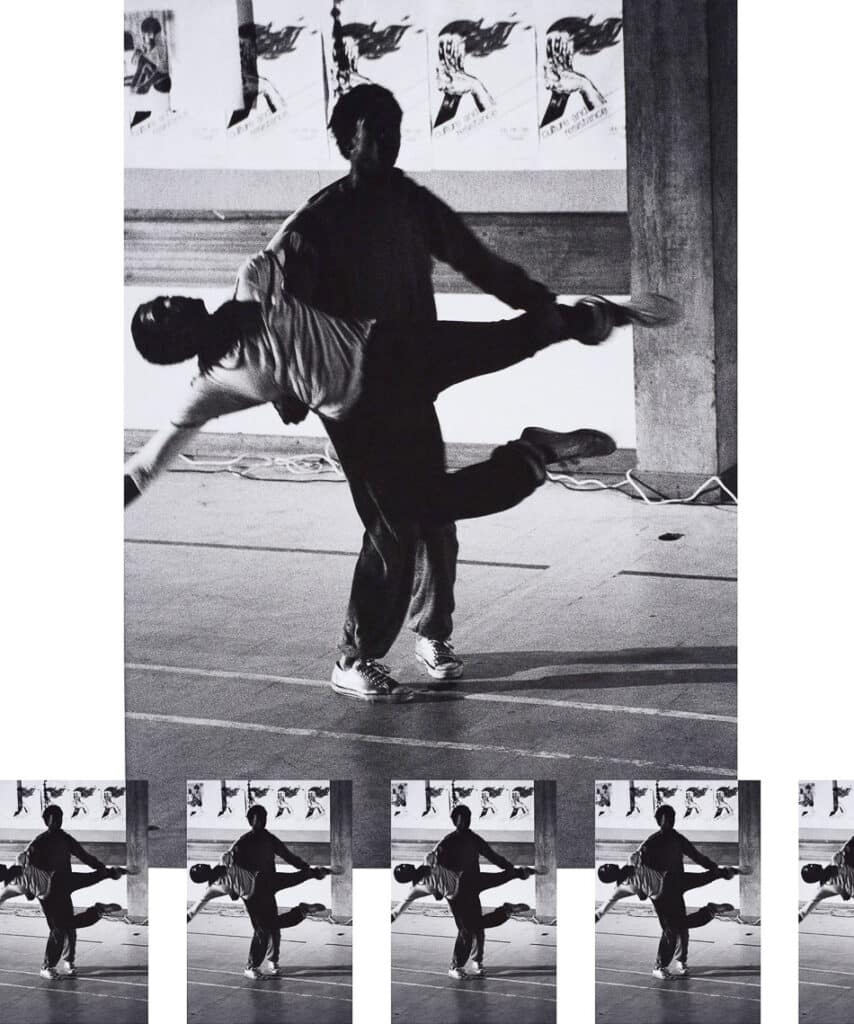
Dancers perform during the Culture and Resistance Symposium and Festival of the Arts at the University of Botswana in Gaborone, 1982. (Credit: Anna Erlandsson via Freedom Park)
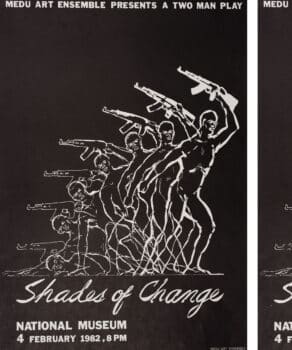
Medu Art Ensemble, Shades of Change, 1982. This two-man play, set in a prison cell, was written by Mongane Wally Serote.
(Credit: Medu Art Ensemble via Freedom Park)
From All Lands
A protest dance. ‘Hai! Hai!’ the crowd chants, knees pumping high, feet stomping, and fingers pointing at an invisible, but known, enemy. With roots in the military drills of the Algerian liberation movement, toyi-toyi, a form of resistance culture that mixes call-and-response chanting with energetic steps, journeyed through the training camps in Tanzania, Zambia, and Zimbabwe in the 1960s. This protest dance arrived at the exiled outposts of uMkhonto we Sizwe (‘Spear of the Nation’, also known as MK), the armed wing of the African National Congress (ANC), before eventually being smuggled back to be popularised in South Africa’s townships and factories.1 Nearly thirty years after the fall of the apartheid regime in South Africa,toyi-toyi has evolved according to the conditions, cultures, and political objectives of those who take it up. It is seen at nearly every protest in the country, from those of the shack dwellers’ movement Abahlali baseMjondolo to the National Union of Metalworkers of South Africa (NUMSA) and from those of the mineworkers in Marikana to the students of the Fees Must Fall movement.
A song. The crowd roars as the legendary South African musician Jonas Gwangwa introduces his next song, Batsumi, to thousands of fans attending the largest annual jazz festival in Johannesburg. It was 2006. The song, however, had been written thirty years before at the height of apartheid rule in South Africa. After years of pursuing his musical career in the United States, Gwangwa made Botswana his home base in the 1970s, soaking in the local Setswana musical traditions and later becoming one of the founding members of the Medu Art Ensemble in 1979, a cultural collective created and based in Botswana whose members were mostly exiled South African artists. Gwangwa’s Batsumi, meaning ‘gather together’, pays homage to the hunting tradition of the First People of Botswana and universalises their historic struggle against oppression as a struggle of people ‘from all lands’ (ba lefatshe lotlhe).2
A poster. The latest issue of the Cuban Tricontinental magazine had just arrived in a remote training camp in Angola. A poster tucked between its pages is unfolded, the four letters C-L-I-K written in yellow font against a night-blue background. Mandla Langa, a South African writer in exile, a Medu member, and an MK soldier deployed there recalls this moment: ‘I remember there was one poster which I can’t forget, from when the Cubans were having power failures, and they wanted to send messages through posters to the villages all over the country of how to conserve energy: Clik. Just switch off’.3 This poster, designed by the renowned Cuban graphic artist Félix Beltrán in 1968, travelled across oceans and continents to arrive at this remote Angolan camp a few years later. Posters and magazines like these were essential in carrying news about the struggles waged elsewhere. People took great risks not just with magazines, but with posters, songs, dances, and poems so that these cultural weapons could reach their intended audiences.
Put together, these vignettes are a drop in an ocean of rich cultural experiences in the South African struggle against white-minority apartheid rule and part of the tradition of liberation struggles across the colonised world. What were the conditions that necessitated and enabled culture to become such a strong mobilising force, both domestically and internationally? What was the Medu Art Ensemble, and what role did cultural groups like it play in pushing that moment of history forward? Over the last few years, Tricontinental: Institute for Social Research spoke with several members of Medu and studied some of the largely unpublished materials that the group produced in its short but deeply impactful years of existence.
The story of Medu is not just a South or southern African story, but an international one. No single liberation struggle can exist without the circulation and exchange of ideas, strategies, material resources, political solidarity, and culture across the globe. Reflecting on the role of national culture in the struggle against colonialism, the Martinican revolutionary Frantz Fanon wrote, ‘It is at the heart of national consciousness that international consciousness establishes itself and thrives. And this dual emergence, in fact, is the unique focus of all culture’.4 In other words, there is no culture of national liberation that is not at once bound up with internationalism. During its six years of existence from 1979 to 1985, the Medu Art Ensemble built and innovated drawing from the cultural practices and artistic theories of African, Asian, and Latin American struggles for national liberation. Thami Mnyele—one of Medu’s founders who was born in the impoverished Johannesburg township of Alexandra and murdered by the South African state for his artistic and political work—described this experience:
It was in [the] Medu Art Ensemble where the role of the artists concretised itself: the role of an artist is to learn; the role of an artist is to teach others; the role of an artist is to ceaselessly search for the ways and means of achieving freedom. Art cannot overthrow a government, but it can inspire change… the whole little ensemble is a workshop, a classroom, a jungle through which the people must carve out a home… The struggle of the artist must be rooted in that of the majority of our people. Any actual engagement in the making of change must of necessity seek inspiration and alliance with the movement of the people.5
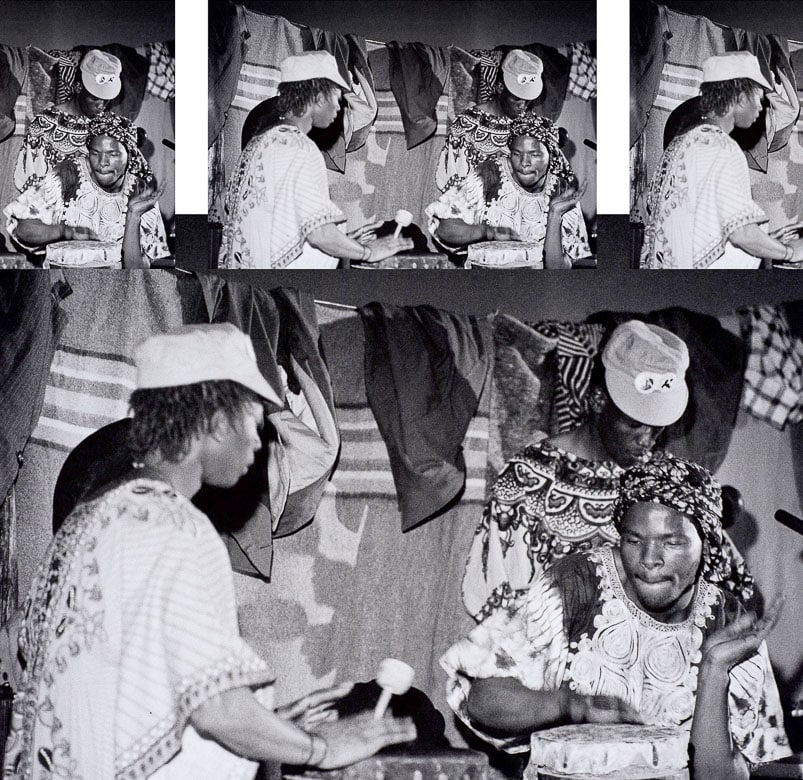
Musicians play the drums at the opening of the Culture and Resistance Symposium and Festival of the Arts at the University of Botswana in Gaborone, 1982. (Credit: Anna Erlandsson via Freedom Park)
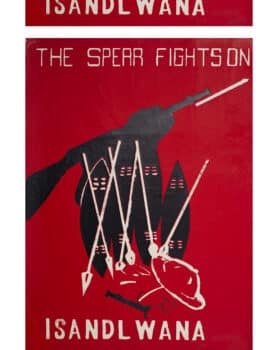
Medu Art Ensemble, The Spear Fights on Isandlwana, 1979. (Credit: Medu Art Ensemble via Freedom Park)
Culture as a Weapon of Struggle
the struggle is food
age-old rule of bloodhounds
gives birth to revolt
the sharp teeth of class struggle
chew off whole epochs
we have travelled a long way
in soweto
we were matadors
trickling bullnosed war tanks
and learned
how much a brick
can bleed a bullet to death— Bheki Langa, ‘Isandlwana Incarnate’, written in 1979 on the 100th anniversary of the Battle of Isandlwana.6
The Medu Art Ensemble emerged as a necessity of a historic moment and out of a centuries-long tradition of cultural resistance on the continent. According to Judy Seidman, a member of Medu’s graphics and research units, the traditions that inspired South African cultural resistance can be categorised in four waves: the early anti-colonial era, the Pan-Africanist movement, and then the first and second waves of South Africans who went into exile.7 Seidman, who is from the United States, spent her youth in Ghana during Kwame Nkrumah’s presidency, dedicated her adult life to the South African liberation movement, and has helped to preserve much of Medu’s history.
The first tradition that inspired South African cultural resistance consisted of different cultural practices that responded to colonial invasions from the seventeenth to early twentieth centuries. An important landmark in this period of resistance was the 1879 Battle of Isandlwana, when warriors of the Zulu Kingdom defeated the British colonial troops who had their sights set on expanding into the diamond and gold-rich interior. This phase of cultural resistance developed alongside the emergence of the South African working classes as a social force, from the nineteenth century mineworkers, railway workers, and dockworkers to the twentieth century factory, domestic, and farm workers, bringing together pre-colonial cultural elements and ideas from the burgeoning international socialist and communist movements.
The second tradition is rooted in the Pan-Africanist movement, which began as early as the first two decades of the 1900s. This period was shaped by leaders like the Trinidadian lawyer Henry Sylvester Williams, women scholars like Anna Julia Haywood Cooper from the United States, and South African writers like Sol Plaatje. In Europe and the United States, Plaatje connected with W.E.B. Du Bois, Langston Hughes, and other key thinkers. By the 1940s and 1950s, the Pan-Africanist movement had incorporated strong Marxist tendencies under the influence of important figures like Kwame Nkrumah (Ghana), Sekou Touré (Guinea), and Amílcar Cabral (Guinea Bissau and Cape Verde) who understood culture to be a fundamental pillar of the struggle against colonialism and for Pan-African unity. A year after assuming the presidency of an independent Guinea, Touré made an important plea to writers, emphasising the symbiotic relationship between cultural production and the revolutionary processes that were underway: ‘To take part in the African revolution it is not enough to write a revolutionary song; you must fashion the revolution with the people. And if you fashion it with the people, the songs will come by themselves, and of themselves’.8
The third tradition emerged in the 1950s with South Africans who were exiled following the consolidation of the racially segregated political system that was formally inaugurated with the 1948 election of the Afrikaner National Party. Despite the implementation of increasingly repressive laws and restrictions, such as the 1950 Group Areas Act, which further racially segregated residential and commercial areas, and the banning of the Communist Party of South Africa under the Suppression of Communism Act that same year, the liberation struggle only grew more militant.9 It no longer demanded inclusion in the existing racialised society, seeking instead to restructure all aspects of South African society. At the height of this moment, the historic Freedom Charter was adopted by the 1955 Congress of the People in Kliptown, just outside of Johannesburg. Beginning with its opening proclamation ‘the people shall govern!’, the Charter addressed the material necessities of land, housing, and work, as well as cultural liberation, declaring that ‘the doors of learning and of culture shall be opened!’.10 This political militancy was met with increased state repression, marked by the Sharpeville Massacre on 21 March 1960 in which the South African Police killed sixty-nine people and injured hundreds more.11 Almost immediately after the massacre, the ANC and the Pan Africanist Congress (PAC), a group whose members had primarily broken away from the ANC Youth League, were banned and forced underground. This generation of exiles, including the renowned musicians Miriam Makeba, Hugh Masekela, and Jonas Gwangwa, interacted with international circuits of political artists and intellectuals, from the Afro-Asian Writers’ Conferences (born out of the 1955 Bandung Conference in Indonesia) to the Pan-African cultural festivals, connecting black artists from the diaspora with those on the continent.
The fourth tradition of cultural resistance came with the exiled South African students and activists who were involved in the Black Consciousness Movement led by Steve Biko. This movement emerged in the midst of the political vacuum of the late 1960s, which reached its height during the Soweto Uprising in 1976, when thousands of students revolted against the imposition of Afrikaans, the language of apartheid domination, as the medium of instruction in black schools. In response, hundreds were killed, affiliated organisations were banned, and many key leaders were exiled or jailed, including Biko, who died a year later in police custody. He was thirty years old. Many of the students and activists politicised in this moment ended up leaving South Africa, including some who went on to form Medu. At the same time, the increasing militancy in the trade union movement, as highlighted by the dockworkers who led the 1973 Durban Strikes and the increasing prominence of trade unionists (among them leaders such as Emma Mashinini), strengthened class consciousness in the artistic community and introduced the concept of a ‘cultural worker’, underscoring the notion that artists and intellectuals are part of the working class.12 By the late 1970s, these political and cultural currents had arrived in Botswana, whose capital, Gaborone, sits a mere fifteen kilometres from the South African border and became a vibrant breeding ground for a new cultural project.
‘Medu started out as a coalescing of the different energies of different people from sometimes almost antagonistic strains’, Mandla Langa recalls regarding his arrival in Botswana. ‘I came from the Black Consciousness Movement, and I was still trying to check [out] the terrain and what was going on. There were people like Wally [Serote] who were already working for the ANC, and there were other young people who were still trying to find their own feet in Botswana’.13 Mongane Wally Serote, who was born in the poor but culturally vibrant black township of Sophiatown and today is South Africa’s National Poet Laureate, spent nine months in solitary confinement in 1969 under the Terrorism Act, which was used to repress many of the first-wave exiles. Within months of the arrival of Serote, Langa, and others in Botswana in the late 1970s, the idea of building a cultural collective such as Medu began to take root. In fact, the word medu means ‘roots’ in the southern African language of Sesotho.
In addition to bringing together various tendencies and traditions, South African activists and artists exiled in Botswana were exposed to a much broader world of liberation struggles from across the continent and the world. ‘The whole of southern Africa was gripped in liberation struggles—Angola, Zimbabwe, Mozambique, Namibia, and so on’, founding Medu member Wally Serote explains. ‘And so, we extended our reach to those other countries which were also in struggle, and after we had discussed maybe for a year, we felt we should formalise the matter [of creating Medu] and anchor it’.14 It was in this context that the Medu Art Ensemble was born. Medu was divided into six creative units: theatre, graphic arts and design, publications and research, film, music, and photography. Led by an annually elected executive body, Medu’s stated aims, in its own words, included:
- training Botswana nationals and exiles in the above-mentioned skills,
- fostering an environment suitable for cultural work,
- creating closer relations between cultural workers and the community,
- establishing closer relations and practical cooperation amongst Southern African cultural workers.15
Medu established a number of programmes, especially practical workshops in various artistic areas for local and South African artists and students. In Botswana, it was also important to create a legitimate front for exiles to work, gain access to resources, and build bridges with local communities without deepening the tensions with the hosting government. For Serote, having different creative units was important in allowing Medu to create a reciprocal relationship that put the organisation ‘at the disposal of our people, so there was feedback for us, and we also fed back to the communities’.16
Breaking from the isolation imposed by the apartheid regime, exiled South Africans expanded their horizons both artistically and ideologically. ‘There were a lot of ideological teachings behind all this’, Langa recalls. ‘We were just learning about Amílcar Cabral’s Return to the Source and the primacy of culture in the struggle. We were meeting writers like Pepetela [and] understood how Angolans, under the leadership of [President] Agostinho Neto, were bringing [a] cultural impetus into their own struggle. There were also writers like Mário de Andrade from Brazil and Abdias do Nascimento, who was a Pan-Africanist’.17 In addition to building good relationships, securing resources, and expanding their ideological and creative exposure, Medu needed to be ‘anchored’, as Serote calls it, in a concrete political project.
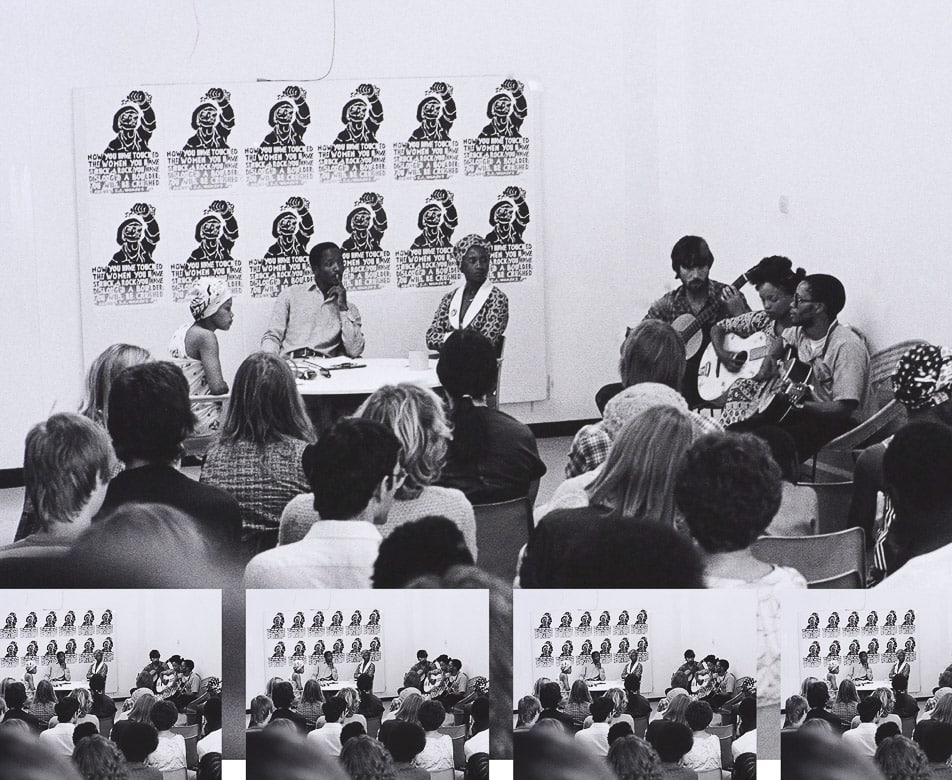
Medu members Lulu Emmig and Thami Mnyele (seated at the table in the front, from left to right) attend a Woman’s Day function at the Swedish Embassy in Gaborone, Botswana, 1981. (Credit: Sergio-Albio Gonzalez via Freedom Park)
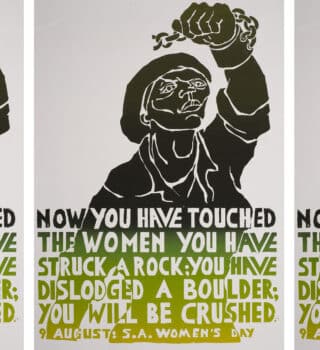
Medu Art Ensemble, Now You Have Touched the Women, You Have Struck a Rock, 1981.
(Credit: Medu Art Ensemble via Freedom Park)
To Anchor Yourself
Sobashiy’abazali’ekhaya
Sophuma sangena kwamany’amazwe
Lapho kungazi khon’ubaba no mama
silandel’inkululekoWe will leave our parents at home
We go in and out of foreign countries
To places our fathers and mothers don’t know
Following freedom— Sobashiy’abazali (‘We Will Leave Our Parents’), a popular freedom song in the training camps.18
Although many of Medu’s core leaders were already members of the ANC and affiliated with its underground work, the organisation itself was not conceived as an official cultural front of the ANC. For founding members of Medu like Serote, to be anchored in a political project did not mean to be bound by the colonial borders of nation, race, or language, but to be at the service of the various national liberation struggles being waged. ‘Once you conceptualise a structure like we did in the context of southern Africa, it means that you are going to anchor yourself in FRELIMO [Mozambique Liberation Front], you’re going to educate yourself in [Namibia’s] SWAPO [South West Africa People’s Organisation], you’re going to act and call yourself a part of the Angolan liberation movement’.19 In order to be able to work across political divisions and attract a broad range of artists and activists, Medu established itself as a ‘non-aligned’ organisation, as Serote describes it, that was open to people from different backgrounds and political trajectories. For him, a guiding factor was that their ‘work was anchored in liberation struggles’.20
To produce cultural work while being anchored in a liberation struggle is not an easy task. Songs were composed, paintings painted, and poems written in extremely difficult conditions. Barry Gilder, a member of Medu’s music unit who is currently South Africa’s ambassador to Syria and Lebanon and worked closely with Serote, recalls their day-to-day life as cultural workers and political militants: ‘In between the clandestine meetings of the RPMC [Regional Politico-Military Council of the MK in Botswana], the highly secretive meetings with contacts at home, the extensive reading of reports from those contacts, the writing of voluminous reports to Lusaka, the dodging of the Botswana Special Branch, and the constant threat of apartheid death raids, Serote continued with his writing career’.21
With many of Medu’s more than sixty known members often working clandestinely, it is impossible to capture the breadth and depth of the organisation’s cultural production during its six years of existence.22 As is the case with any national liberation struggle, there is no single historical archive that makes Medu’s artefacts and cultural productions accessible to the public. One of its largest retrospectives,The Peoples Shall Govern! Medu Art Ensemble and the Anti-Apartheid Poster, was organised by the Art Institute of Chicago in 2019, featuring 130 of Medu’s artworks and artefacts, including 60 of its 90 known posters. Still, this history remains largely out of reach to South Africans engaged in social and political movements today and younger generations of cultural workers around the world. Nonetheless, what has been documented demonstrates an impressive range of creative experimentation and a high-quality body of work. Medu’s publications and research unit worked in conjunction with the other units to produce a newsletter filled with poetry, short stories, reviews of exhibitions, literary criticism, interviews, and political analyses by the organisation’s members and artists alongside thinkers from other countries. Revolutionary poems by Tố Hữu in Vietnam and essays by the Kenyan author Ngũgĩ wa Thiong’o, for instance, were interspersed with Medu’s writings, whose authors found themselves in the process of articulating their own practices and theories on the art of national liberation.
Among Medu’s most impressive achievements was the Culture and Resistance Symposium and Festival of the Arts, held from 5 to 9 July 1982. According to different accounts, anywhere from hundreds to thousands of people attended the festival, with cultural workers arriving in the small city of Gaborone in cars and on buses while others hitchhiked or flew. Over these five days, both South Africans who were living in exile and ‘inziles’, those living their own ‘exiled’ existence within South Africa, along with people from Europe, the United States, and across southern Africa gathered at the University of Botswana to discuss the essential role of culture in accelerating the struggle for South African liberation, which was becoming more imminent each day. Wally Serote, Thami Mnyele, and Sergio-Albio González (a Medu member originally from Cuba) led the initial preparations for the conference, inviting a range of Batswana and South African organisations to join the planning process over the next two years.23
The Culture and Resistance Symposium and Festival of the Arts, following a long lineage of conferences and festivals held in Africa, Asia, Latin America, and Europe, represented ‘the first significant opportunity in decades for South Africa-based and exiled South African artists to engage each other—directly, intensely—through papers, discussions, performances, and social interaction’, Barry Gilder recalls, having attended several conferences in exile held in the 1970s and 1980s.24 Though no formal declarations were made, the conference brought people together from across political, racial, social, and geographic divides to build towards a liberated South Africa. They not only talked about but created culture together during the festival, which gave birth to new formations of resistance. Amongst the most significant was the United Democratic Front, which was formed a year after the festival by many of its key participants and would mobilise the masses to deal a lethal blow to the apartheid system.
Eighty-seven cultural workers from diverse backgrounds contributed over 300 paintings, sculptures, and photographs to the Art Toward Social Development exhibition that accompanied the festival. These works embodied fear and despair, but also optimism and hopefulness.25 ‘It is this element of optimism and hopefulness’, Thami Mnyele said in his speech on the opening night, ‘which has brought us all together tonight; it is this indestructible and enduring spirit of struggle that nourishes our quest for social development and justice’.26
The festival included performances across artistic genres, such as the Junction Avenue Theatre Company’s production of Marabi, a musical theatre piece that recovered the vibrant cultural life of the African working class and featured jazz music, dance parties, and beer-brewing in the shebeens (taverns that existed before forced removals began in the 1930s as part of urban segregation policies). There were also several musical performances featuring Hugh Masekela on the trumpet, Barry Gilder on the guitar, and Abdullah Ibrahim (known then as Dollar Brand) on the piano, who closed off his set with a melancholic melody of Tula Dubula, sung with a glimmer of hope:
There’s a new world a-coming,
falsehood will all be gone.
They’ll come a-marching
into town at dawn;
singing songs of freedom,
and laughing in the rain.
Gone will be this old world,
things won’t be the same.27
Though it is difficult to capture the spirit of the times, the cultural debates and experiments highlighted at the symposium and festival, and throughout Medu’s existence, remain relevant for cultural workers engaged in political struggles today. What follows is an attempt to distil some of the theories that emerged from Medu’s practices about the ideology, strategy, form, and content of revolutionary culture as well as the age-old tension between art and politics. Together, they point us towards a theory of art for national liberation.
The necessity of art. ‘The Necessity of Art for National Liberation’ was the title of the opening speech given by Medu member Dikobe wa Mogale Ben Martins at the Culture and Resistance Symposium and Festival of the Arts. Its title references the classic book by the Austrian art historian Ernst Fischer, The Necessity of Art: A Marxist Approach (1959). For Fischer, the major task of art—specifically socialist art—is two-fold: ‘to lead the public towards a proper enjoyment of art, that is to say, to arouse and stimulate their understanding, and to emphasise the social responsibility of the artist’.28 In other words, the artist must help conscientise the people and has a social duty to do so. Similarly, for Dikobe wa Mogale, in a society of class and racial oppression, artists cannot hide behind ‘artistic neutrality’. If culture is indeed a weapon of struggle, then, he said, ‘art must teach people, in the most vivid and imaginative ways possible, to take control over their own experience and observations [and] how to link these with the struggle for liberation and a just society free of race, class, and exploitation’.29
This artistic responsibility was also emphasised in the writings of Thami Mnyele, a key Medu member who helped theorise the organisation’s work. Having grown up in the Alexandra township in northeast Johannesburg, Mnyele was angered by the oppression and underdevelopment inflicted upon black communities and by the sanitising selectiveness of ‘township art’ that galleries deemed palatable for white audiences and buyers. In a written exchange with Dikobe wa Mogale on ‘artistic neutrality’, Mnyele asked: ‘In the face of so much grief, suppression, and repression (homeless squatters, death sentences, war in Angola, starvation), how do we explain our works and daily activities or inactivities? What credibility do we deserve from the people?’.30 For Mnyele, credibility is earned by creating art that serves the people and that ‘clearly popularise[s] and give[s] dignity to the just thoughts and the deeds of the people. With our brushes and paints, we shall need to visualise the beauty of the country we would like our people to live in’.31 Art is necessary for building a future, socialist, society while providing the spiritual shelter for a people that are still in the process of liberating themselves.
No revolutionary soloist. Even with the social responsibility of the revolutionary artist established, the relationship between the individual artist and the collective is often tenuous in practice. Socialist artistic traditions reject the ideas of ‘art for art’s sake’ and ‘artistic freedom’ inherited from nineteenth century Romanticism and liberalism, which centre the creativity, aspirations, and even protest of the individual over the collective. But during revolutionary times, which were brewing across southern Africa, the conflict between the individual and the collective heightens. Keorapetse William Kgositsile (or ‘Bra Willie’), a leading Medu member who later became South Africa’s first National Poet Laureate, reflected on this tension in his keynote speech at the Culture and Resistance Symposium and Festival of the Arts. He began with an anecdote about a fellow South African writer who asked him how he ‘still manage[d] to write novels and poems’, suggesting that his active political engagement was at odds with his creative production. Kgositsile replied: ‘with a bit of acid on my tongue, I had always wondered how a South African writer could be outside the movement but hope to write anything of value or significance’.32 Affirming the fact that artistic production arises from concrete social relations, Kgositsile continued: ‘There is no such creature as a revolutionary soloist. We are all involved. The artist is both a participant and imaginative explorer in life. Outside of social life there is no culture, there is no art; and that is one of the major differences between [hu]man and beast’.33 As an antidote to the plague of individualism, Mnyele emphasised the importance of organisation and organising skills as one of the ‘most effective weapons against our problems’.34 An artist who is socially responsible is therefore an artist who is organised alongside the people, a part of—and not apart from—their movements.
To be understood. For art to fill its social function, it must be understood by the people. One of Mnyele’s diagnoses of contemporary South African artists was that their work was ‘acutely abstracted’, ‘lost to the mystical’, and plagued with ‘distortion’.35 In other words, their artwork confuses and distracts rather than clarifying and enabling its viewers to better understand the world around them. As a result, Mnyele explained, ‘the work has lost that essential quality of community, the immediacy of communication with the masses [to whom] the artist claims to address himself’.36
In the early 1980s, the trends that dominated the Western art world—to which liberation movements were not immune—were filled with abstraction, from the minimalist stainless steel sculptures of Jeff Koons to the pop art of Andy Warhol. This was no accident. Abstraction as an aesthetic style was even deployed by the Central Intelligence Agency to counter the Soviet tradition of socialist realism during the Cold War, a form of cultural warfare that continues today. In the 1950s, artists like Jackson Pollock, through his abstract ‘drip paintings’, were actively promoted internationally to represent the rugged individualism and anti-communism of United States culture.
‘The West was viciously anti-Soviet socialist realism and so how you made art in the context of a liberation movement was actually an issue’, Judy Seidman recalls, speaking of the ‘endless arguments’ about socialist realism that defined this period.37 It was common for artists of the time to criticise ‘posters of people with clenched fists [for being] socialist realist in the worst possible sense of the word’. She recalls what Mnyele used to say to the naysayers of the ‘fists and spears’ style of art: ‘When I go to meetings and I draw people with fists in the air, it’s because that’s what I’m seeing and that’s what I’m drawing’. To Seidman and Mnyele, it is neither possible nor responsible to exclude representations of the realities of the people in their art. Rather than adhering to a rigid style, Medu members aimed to make art that reflected the concrete realities of the people, with all their horrors, pain, and injustice, while at the same time instilling the confidence that these realities can be changed. In order to achieve both tasks, a work of art must be able to be understood by the people for whom it is made.
Towards socialist art. As a non-aligned, non-racial,38 and ideologically diverse organization, Medu did not have a singular practice or theory around art. Through analysing some of their writings and debates, however, one could say that the group was moving towards a theory and practice of socialist art and towards restoring art to its social function, which capitalism and colonialism had destroyed. Medu members borrowed from different aesthetic and liberation traditions in order to break from the grip of the art galleries of the ruling class, which, according to Mnyele, were ‘not only the monopoly outposts and shrines of African art, but they even determine[d] what form and content the art should take’.39 So instead, they looked to socialist muralists like David Alfaro Siqueiros and Frida Kahlo in Mexico and to Marxist cultural theorists like Bertolt Brecht and Ernst Fischer. For instance, Fischer’s formulation of socialist art as that which ‘anticipates the future’ with the past ‘woven into its fabric’ is echoed in Mnyele’s own historical and materialist understanding of the development of art and aesthetics.40
Medu’s members were inspired by communist artists around the world, from the songs of the Chilean musician Victor Jara to the poetry of Vietnamese writer Tố Hữu. They learned from the cultural thinking of national liberation struggles of the Marxist tradition, like that of Amílcar Cabral, Frantz Fanon, and Mao Zedong, whose theories and practices they adapted to their own realities. Serote recalls, for instance, that ‘There was a lot of influence, especially from Mao. We read a lot about that and we also discussed it and always asked ourselves, “how do we ensure that the two interact and influence each other, and what [do] we get from China and what we want to do in southern Africa and South Africa?”’.41
The path towards socialist art can be understood more as an outlook, a method, and an attitude, rather than a monolithic style, and in many ways, this is the orientation that Medu upheld and attempted to articulate as revolutionary processes unfolded. Given Medu’s tragic and premature end, it is impossible, of course, to predict where those practical and theoretical innovations might have taken them.
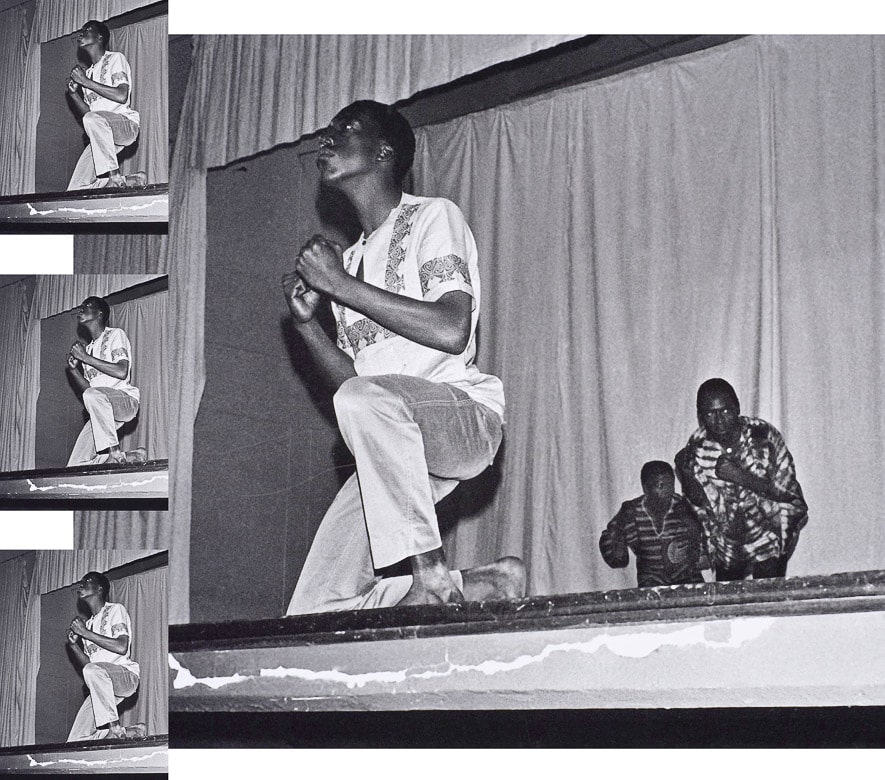
Actors rehearse Marumo by playwright Mandla Langa at the Gaborone Town Hall in Gaborone, Botswana, 1979.
(Credit: Sergio-Albio Gonzalez via Freedom Park)
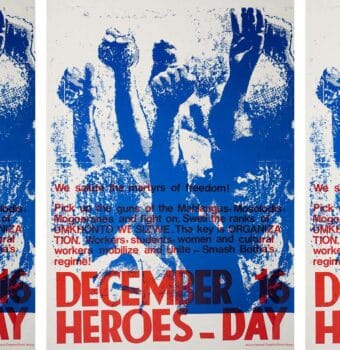
Medu Art Ensemble, December 16—Heroes Day, 1983. (Credit: Medu Art Ensemble via Freedom Park)
My Blood Will Nourish the Tree Which Will Bear the Fruits of Freedom
Didn’t you hear him today
Even right now
Sing his poem of love
Write an epitaph of love
With LIFE
‘My blood will nourish the tree
Which will bear the fruits of freedom’…Yes for him too with LIFE
We must reach freedom’s rich estates…
Marching
To the unbroken rhythm
Of surging dancing spears— Lindiwe Mabuza, ‘Epitaph of Love’ (in memory of Solomon Mahlangu, executed in 1979).42
On the evening of 13 June 1985, a truck carrying sixty-three men from the South African Defence Force and an arsenal of rifles, 9mm pistols, stun grenades, gas masks, and more crossed the border into Botswana. Some sixty other tanks and armoured vehicles were on standby.
It was 1:15am when a team of eight men arrived at Thami Mnyele’s house. He was still awake. Within minutes, his entire house, his artwork, and Mnyele himself had been sprayed with bullets. He died trying to climb the fence next to a thorn tree while his pens laid uncapped, ink freshly spilt. Perhaps his last act in life was painting those very thorns, which he often did to show not only the beauty but also the pain and violence of this world.43
Michael Frank Hamlyn. Cecil George Phahle. Lindiwe Phahle. Joseph Malaza. Themba Duke Machobane. Dick Mtsweni. Basil Zondi. Ahmed Geer. Gladys Kesupile. Eugenia Kolobewere. Six-year-old Peter Masoke.44 These are the twelve people—two of them Medu members—who were identified as victims of the raids conducted that night by the South African Defence Force Special Forces in the sovereign territory of Botswana, while others who had gotten wind of a possible attack narrowly escaped. Some surviving Medu members and activists stayed in Botswana after the murders while others were deployed elsewhere to continue their political and artistic work. Nonetheless, this operation marked the end of the Medu Art Ensemble. In 2002, seventeen years after the raid, the Truth and Reconciliation Commission argued that the cross-border action was not within their area of competence, and the only men who were tried were those who collated information on the targets. They were granted amnesty. Today, even further removed from the times and conditions that produced Medu, what can and should be recovered from this history for those engaged in struggles and cultural work?
Mandla Langa reflects on Medu’s ideological clarity during the South African liberation struggle and how the concept of nation and the Marxist analysis of class helped frame their understanding of who the oppressed in South Africa were. ‘Unfortunately, today, everything has been muddled up’. He compares South Africa’s young democracy to ‘an older adolescent’ with ‘hormonal impurities’ that require ‘a lot of unlearning’ to get on the right path.45 Along the same lines, Barry Gilder points to the importance of preserving history in the process of transitioning to state power: ‘We had a fear, a sensitivity about our history, our cultural history, our songs, and so on. Fear of offending those that we reconciled with’.46 To him, the process of reconciliation was also a process of forgetting critical and hard-earned lessons that came from revolutionary struggle, including in the realm of culture. Similarly, Serote laments the loss of internationalist cultural exchanges since the liberation period: ‘I can’t remember when last I read a novel from China… We have a lot of literature like that in our bookshops from [the United States of] America, Europe, and so on, but not from Vietnam, not from China, not from Cuba. There’s something wrong’.47
There is no doubt that South Africa’s transition to democracy did not deliver the liberation to the majority of its people that so many fought and died for, that its process of national liberation is incomplete. The Freedom Charter is far from being realized, and South Africa remains an extremely divided and unequal society in which the top, mostly white, 10 per cent of the population own 85 per cent of the country’s aggregate wealth.48 The process of national liberation does not end with the formal transfer of power from colonial hands, nor with the fall of an apartheid regime. Class society does not disappear overnight in a socialist project, and imperialism does not sit idly by as nations and peoples attempt to chart a sovereign path. Rather, liberation continues to be a process, and a struggle, that must be fashioned by and with the people continuously.

Medu members Tim Williams, Wally Serote, and Sergio-Albio Gonzalez print the poster ‘Unity Is Power’ in Gaborone, Botswana, 1979.
(Credit: Teresa Devant via Freedom Park)

Medu Art Ensemble, Unity Is Power, 1979.
(Credit: Medu Art Ensemble via Freedom Park)
Opening the Future
A poster. Dozens gather in a conference hall in the Diakonia Council of Churches in Durban, South Africa. It is October 2020, at the height of the global pandemic, and Abahlali baseMjondolo (AbM) is organising this and other events to celebrate its fifteenth anniversary. Since its founding in 2005, AbM has built a democratic self-organised movement of the poor and dispossessed in South Africa, occupying land, securing housing, producing food, and politically educating its 100,000 members. A large, centrally placed banner reads: ‘Fifteen years of our revolutionary struggle for land, housing, and dignity’. Below it are posters by artists and activists from around the world, from Cuba to India, Venezuela to Lebanon, Brazil to Indonesia. This artwork is part of the four-part series of Anti-Imperialist Poster Exhibitions, jointly organised by Tricontinental: Institute for Social Research and the International Week of Anti-Imperialist Struggle.49 For the celebration, AbM members selected from the more than 200 posters that bear witness to peoples’ struggles internationally, which resonate with their own realities on the ground. Amongst them is a hand-drawn portrait honoring Thuli Ndlovu, AbM’s chairperson in KwaNdengezi and one of the twenty-five leaders who have been assassinated since the movement’s founding.50 Above it is a poster that Medu’s own Judy Seidman produced for the Anti-Imperialist Poster Exhibitions, which travelled around the world and the internet before landing on these walls in Durban. The poster reads, ‘Capitalism kills, but we shall rise’.
In Kgositsile’s speech at the 1982 Culture and Resistance Symposium and Festival of the Arts, he said: ‘Our artists have over the years struggled along with the people, sensitised to and expressing the feelings, sufferings, hopes, failures and achievements in our struggle for national liberation’.51 Writing about the story of Medu and the southern African liberation struggles today is not a nostalgic endeavour. This attempt aspires, as Fanon wrote, ‘to use the past with the intention of opening the future, as an invitation to action and a basis for hope’.52 Art, therefore, has the capacity to capture both our collective victories and defeats, including the story of the Medu Art Ensemble, and turn them into a mobilising force for the struggles of today and those yet to come. In fact, the artist has a responsibility to do so.
Notes:
- ↩ Shirli Gilbert, ‘Singing against Apartheid: ANC Cultural Groups and the International Anti-Apartheid Struggle’, Journal of Southern African Studies 33, no. 2 (June 2007): 434.
- ↩ Gwen Ansell (Director of the Institute for the Advancement of Journalism in South Africa), interview by Tings Chak, Johannesburg, South Africa, 11 October 2019.
- ↩ Mandla Langa (Director of the Contemporary African Music and Arts organisation), Zoom interview by Tings Chak, 15 July 2020. For more on the history of Cuban posters, see Tricontinental: Institute for Social Research, The Art of the Revolution will be Internationalist, dossier no. 15, 8 April 2019, thetricontinental.org.
- ↩ Frantz Fanon, The Wretched of the Earth, trans. Richard Philcox (New York: Grove Press, 2004), 180. For more on Fanon, see Tricontinental: Institute for Social Research, Frantz Fanon: The Brightness of Metal, dossier no. 26, 2 March 2020.
- ↩ Thami Mnyele, ‘Observations on the State of the Contemporary Visual Arts in South Africa’, in Thami Mnyele + Medu Art Ensemble Retrospective, eds. Clive Kellner and Sergio-Albio González (Johannesburg: Jacana, 2009), 27.
- ↩ Bheki Langa, ‘Isandlwana Incarnate’, Medu Art Ensemble Newsletter 5, no. 1 (1984): 28, Judy Seidman’s private collection.
- ↩ Judy Seidman, ‘Mayibuye iAfrika: Thoughts on Subterranean Archives; The Untold Story of South Africa’s Art in Africa’, keynote address given to CFP: Conference on Recovering Subterranean Archives, Stellenbosch University, 17—18 January 2019, unpublished, Judy Seidman’s private collection.
- ↩ Sekou Touré, ‘The Political Leader Considered as the Representative of a Culture’, paper presented at the Second Congress of Black Writers and Artists, Rome, 1959, quoted in Fanon, The Wretched of the Earth, 206.
- ↩ For more on the early period of the Communist Party of South Africa and the resistance movement after its banning, see Tricontinental: Institute for Social Research, Josie Mpama, Studies on Feminisms no. 5, 21 March 2023, thetricontinental.org.
- ↩ ‘Freedom Charter’, Department of Education, Government of South Africa, 2005, www.dffe.gov.za, 12—13.
- ↩ For more on the history of mid-century politics and the Black Consciousness Movement, see Tricontinental: Institute for Social Research, Black Community Programmes: The Practical Manifestation of Black Consciousness Philosophy, dossier no. 44, 10 September 2021, thetricontinental.org.
- ↩ Tricontinental: Institute for Social Research, The 1973 Durban Strikes: Building Popular Democratic Power in South Africa, dossier no. 60, 24 January 2023, thetricontinental.org and ‘Strikes Have Followed Me All My Life’, newsletter no. 37, 12 September 2019, thetricontinental.org.
- ↩ Langa, interview by Tings Chak.
- ↩ Mongane Wally Serote (National Poet Laureate and chief executive officer of the Freedom Park Trust), Zoom interview by Tings Chak, 14 September 2023.
- ↩‘A Brief Description of Medu Art Ensemble’, in Thami Mnyele + Medu Art Ensemble Retrospective, eds. Clive Kellner and Sergio-Albio González (Johannesburg: Jacana, 2009), 77—78.
- ↩ Serote, interview by Tings Chak.
- ↩ Langa, interview by Tings Chak.
- ↩ Gilbert, ‘Singing Against Apartheid’, 433.
- ↩ Serote, interview by Tings Chak.
- ↩ Serote, interview by Tings Chak.
- ↩ Barry Gilder, ‘Of Activist Writers and Cultural Conferences in Exile: Political, Literary, and Personal Implications’, in Mintirho ya Vulavula: Arts, National Identities, and Democracy, eds. Innocentia J. Mhlambi and Sandile Ngidi, (Johannesburg: Mapungubwe Institute, 2021), 174.
- ↩ Antawan I. Byrd and Felicia Mings, eds., The People Shall Govern! Medu Art Ensemble and the Anti-Apartheid Poster 1979—1985 (New Haven and London: Yale University Press, 2020), 136.
- ↩ Clive Kellner and Sergio-Albio González, eds., Thami Mnyele + Medu Art Ensemble Retrospective(Johannesburg: Jacana, 2009), 158.
- ↩ Gilder, ‘Of Activist Writers’, 162.
- ↩ Kellner and González, Thami Mnyele, 186.
- ↩ Thami Mnyele, Opening Remarks 1982 South African Exhibition, July 1982, unpublished paper, Judy Seidman’s private collection.
- ↩ Abdullah Ibrahim, ‘Tula Dubula’, Antiwar Songs, accessed 30 September 2023, www.antiwarsongs.org.
- ↩ Ernst Fischer, The Necessity of Art: A Marxist Approach (New York: Penguin Books, 1959), 210.
- ↩ Dikobe wa Mogale Ben Martins, ‘The Necessity of a National Art for Liberation’, speech delivered at the Culture and Resistance Symposium and Festival of the Arts, 5 July 1982, unpublished, Judy Seidman’s private collection.
- ↩ Thami Mnyele, ‘Art Can Never Be Neutral’, paper written on 23 September 1981, unpublished, Judy Seidman’s private collection.
- ↩ Mnyele, ‘Observations’, 27.
- ↩ Keorapetse William Kgositsile, ‘Culture and Resistance in South Africa’, Medu Art Ensemble Newsletter 5, no. 1 (1984): 23, Judy Seidman’s private collection.
- ↩ Kgositsile, ‘Culture and Resistance’, 29—30.
- ↩ Mnyele, ‘Observations’, 26.
- ↩ Mnyele, ‘Observations’, 25.
- ↩ Mnyele, ‘Observations’, 25.
- ↩ Judy Seidman (cultural worker and visual artist), interview by Tings Chak, Johannesburg, South Africa, 8 June 2020.
- ↩ Non-racialism is a prominent ideology and political tradition in South Africa that was born out of opposition to the racialised system of apartheid. The term is enshrined as a founding value in chapter one of the Constitution of South Africa, although its precise meaning is contested by different political forces. The Communist Party of South Africa was a leading organisation of non-racial politics, whilst, for example, the ANC reserved its membership exclusively for Africans up until 1969. See Imraan Buccus, ‘The Dangerous Collapse of Non-Racialism’, New Frame, 30 July 2021.
- ↩ Mnyele, ‘Observations’, 25.
- ↩ Fischer, The Necessity of Art, 111.
- ↩ Serote, interview by Tings Chak.
- ↩ Lindiwe Mabuza, ‘Epitaph of Love’, Medu Art Ensemble Newsletter 5, no. 1 (1984): 27, Judy Seidman’s private collection.
- ↩ Diana Wylie, Art and Revolution: The Life and Death of Thami Mnyele, South African Artist(Charlottesville: University of Virginia Press, 2008), 201—202.
- ↩ Kellner and González, Thami Mnyele, 192.
- ↩ Langa, interview by Tings Chak.
- ↩ Barry Gilder (South Africa’s ambassador to Syria and Lebanon), Zoom interview by Tings Chak, 8 August 2023.
- ↩ Langa, interview by Tings Chak.
- ↩ ‘Wealth Distribution in South Africa’, World Inequality Database, 16 April 2020, wid.world.
- ↩ Anti-Imperialist Poster Exhibitions, International Week of Anti-Imperialist Action and Tricontinental: Institute for Social Research, July—December 2020, antiimperialistweek.org.
- ↩ For more on this history, see Tricontinental: Institute for Social Research, ‘The Politic of Blood’: Political Repression in South Africa, dossier no. 31, 4 August 2020, thetricontinental.org.
- ↩ Kgositsile, ‘Culture and Resistance’, 29.
- ↩ Frantz Fanon, The Wretched of the Earth, trans. Constance Farrington (New York: Grove Press, 1963), 232.

